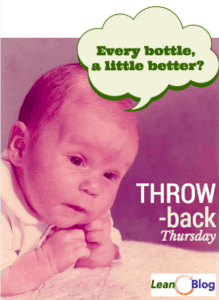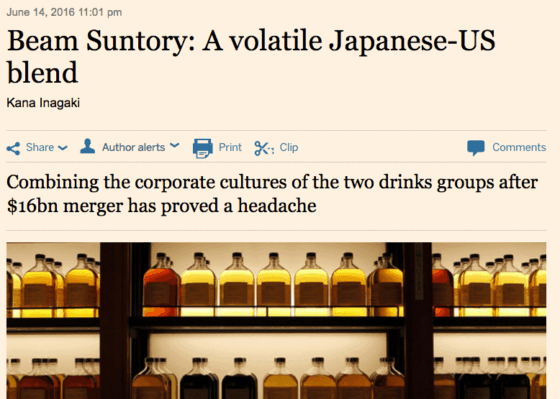L ast year, I wrote a blog post about the intersection of two things I like a lot: Kaizen and whiskey: “Why Kaizen is an Important Differentiator for Japanese Whisky.” Yeah, the spelling of whiskey/whisky isn't standardized :-)
ast year, I wrote a blog post about the intersection of two things I like a lot: Kaizen and whiskey: “Why Kaizen is an Important Differentiator for Japanese Whisky.” Yeah, the spelling of whiskey/whisky isn't standardized :-)
The article talked about how the Japanese distiller Suntory practices “Kaizen” in an attempt to continuously improve their product. I'd presume this also applies to the continuous improvement of their processes, too.
You might have seen my recent blog post about applying Kaizen to a process at Garrison Brothers distillery.
I recently saw an article in the Financial Times about some challenges that have popped up after Suntory purchased the famed American brand and distillery, Jim Beam:
“Beam Suntory: A volatile Japanese-US blend“
This story reminds me of fictional, comic tensions in the movie “Gung Ho” about a Japanese company buying an American car plant. That movie came out in 1984, the same year that Toyota & GM partnered together on the NUMMI plant in California.
There were real tensions in that plant when I visited in 2005 or so. I talked to a GM safety manager who was on assignment at NUMMI and he really went out of his way to tell me that he thought Toyota wasn't as good as GM on safety, etc. I sensed a mix of GM/American pride and defensiveness about being sent out to learn from Toyota.
Is the same thing happening at Jim Beam?
From the FT article:
“Just months after Suntory's $16bn takeover of US spirits maker Beam in 2014, the chief executive of the Japanese whisky group dropped a bombshell. The quality of the Kentucky-made Jim Beam bourbon could be improved, he suggested, if its distillers employed a Japanese process called kaizen. Matt Shattock, the chief executive of Beam, cringed at the proposal made by his counterpart, Takeshi Niinami. It was seen as a direct affront to the formula perfected by the Jim Beam family over two centuries.”
It seems like a factual statement that everything can be improved. Nobody's perfect and no product is perfect.
Pointing out this fact led to tension and conflict:
“The Suntory chief was suggesting only minor tweaks to the water purification process, not a change to the Beam recipe. But the mere hint of meddling, raised during a board meeting, caused damage. It strained relations just as the two sides were wrestling with how to make a success of the collaboration between the US bourbon maker and its Japanese owner, known for its Yamazaki and Hakushu whiskies.”
It sounds like they have been working through that tension:
“For workers at Beam, this sounded like criticism of their long-established practices.
“Initially, the interactions were perceived as highly insulting, until we reached mutual understanding regarding culture and intention,” says Vincent Ambrosino, Beam's former chief financial officer who moved to Tokyo to serve as a senior adviser to Mr Niinami and Mr Hizuka. “Eventually, we figured out that we shared a common objective.“
There's always a risk of the same tension and conflict happening when I work with a hospital.
It's factually correct to point out that things could be improved in a hospital. Even when I'm very careful to say that we're looking at the process, not criticizing the people, it's not surprising when hospital employees or leaders take things very personally.
We can't control people's emotions and we can't say, “Don't be upset by us pointing out these problems.”
People get even more defensive and upset when we point out problems (huge problems) with patient safety.
Pointing out problems is the first step in improvement. I wouldn't waste my time pointing out problems if I believed the patient safety crisis couldn't be made significantly better or that processes couldn't be improved.
It's helpful to start with that “common objective.” Start with why, as Simon Sinek says.
I'm more interested in “improving healthcare workplaces and results” than I am in “implementing Lean.”
Focusing on the goal AND engaging everybody in defining and solving those problems makes all the difference. That's what moves people forward.
Is some amount of tension a natural part of the improvement process? Or could Suntory have handled this better? Or both?
Please scroll down (or click) to post a comment. Connect with me on LinkedIn.
Let’s work together to build a culture of continuous improvement and psychological safety. If you're a leader looking to create lasting change—not just projects—I help organizations:
- Engage people at all levels in sustainable improvement
- Shift from fear of mistakes to learning from them
- Apply Lean thinking in practical, people-centered ways
Interested in coaching or a keynote talk? Let’s start a conversation.






![When Was the Last Time a Leader Around You Admitted They Were Wrong? [Poll]](https://www.leanblog.org/wp-content/uploads/2025/07/Lean-Blog-Post-Cover-Image-2025-07-01T212509.843-238x178.jpg)




Comments from LinkedIn:
Thomas Cox: Outstanding example of how human factors (ego, pride, fear, misunderstanding) can easily derail our efforts to improve.
Joe Thomas: hard to believe that there might be cultural friction between Kentucky and Tokyo!
Also from LinkedIn:
My reply:
I think that’s why the advice of Taiichi Ohno is still timeless and helpful. “Start from need.” Start from your most pressing need, as he said. As John Shook asks, “What problem are you trying to solve?” That’s always more effective than “let’s do kaizen” or “let’s implement Lean.”